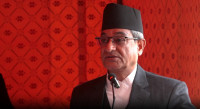National
Nepali public sees ‘view towers’ in rural areas as misplaced spending
Observers and experts say scarce funds should have been used in necessary infrastructures like health facilities and schools.
Shuvam Dhungana
On Monday, Communist Party of Nepal (Maoist Centre) chair Pushpa Kamal Dahal inaugurated a newly constructed observation tower, popularly known as “view tower”, at Satdobato in Rolpa Municipality-3. Constructed at the cost of Rs60 million rupees from state coffers, it is one of the largest infrastructure projects the local government has built over the last five years.
Dahal’s inauguration of the view tower drew widespread criticism from the public who called it a misplaced priority. While the criticism continued, CPN-UML chair KP Sharma Oli inaugurated another view tower, said to be the second tallest after Kathmandu’s Dharahara, at Tilottama Municipality in Rupandehi district. The local government invested Rs115 million to erect the 10-storey structure.
Nepalis took to Twitter to comment on Nepali politicians’ penchant for inaugurating something least useful like view towers.
After the three tiers of government were elected in 2017, there seems to be a competition going on among local governments to build such concrete structures which observers and experts say are a sheer waste of resources, which could have been used in necessary infrastructures like health facilities and schools.
Even the federal government has poured money to build such “unnecessary” structures. While still a prime minister, Oli had allocated a budget to construct a tall 18-storey tower in his constituency in Damak, Jhapa. A whopping Rs1.5 billion will be spent in the mega structure that is soon to be completed.
The construction of view towers, a tall structure with an observation deck for people to look around, actually reflects the myopic vision of Nepal’s elected representatives, who have failed to see the immediate and pressing needs of the general public, say experts.
“The view towers have never been the demands of the locals. These are the results of unilateral decisions from the people in power,” Khim Lal Devkota, who specializes in federalism and fiscal decentralisation, told the Post. “Let's hope that our leadership has learnt some lessons from the widespread criticism of view tower projects. As the elections are closer we hope the people will elect those who listen to their concerns in the upcoming elections.” The local elections are slated for May 13.
Devkota, however, says it would be wrong to blame only governments for erecting the unnecessary structures. He says in many stances, such towers and the welcome gates, mainly in the Madhes, have been constructed using the budget of the Local Infrastructure Development Partnership Programme allocated to the members of the House of Representatives.
Besides criticism by experts, social media including Twitter are rife with scathing comments against these structures.
Many social media users have viewed the observation towers in rural areas which lack even basic infrastructures as sheer waste of scarce resources with many suggesting that such funds should be used to build schools, hospitals and better roads.
Construction of view towers in different areas has emerged as the most preferred way by elected representatives to spend public funds hard-earned by taxpayers.
Indicating two different photos from two districts in western Nepal, a Twitter user wrote: “Need vs priority – A woman giving birth in the middle of the road in absence of health facilities in Bajura. A view tower was constructed in Rolpa with an investment of millions. System may change, revolution may happen. But real change will never happen unless the mindset of the ruler is changed.”
Replying to the post, another Twitter user wrote: “All these construction of Gates & View Towers in the name of tourism development is backward thinking of the political leaders. Everyone of them has an obsession over gates and view towers, while there are many critical & priority issues to be addressed such as health, education.”
When the decade-long Maoist insurgency started in Nepal on February 13, 1996, the rebels had established their headquarters in Rolpa district.
The government has already spent millions of rupees to develop Rolpa as a “war tourism destination” in memory of those who lost their lives during the insurgency and the view tower is one of them.
The tower, which has also been named as People’s War Memorial view tower, is at an altitude of 2,055 meters. Political experts who have followed the development, say the competition among elected officials to erect view towers and top leaders themselves participating in their inaugurations show the misplaced priority of the Nepali political leadership.
They say the millions of rupees poured in the construction of such towers could have been invested in irrigation, drinking water, public infrastructures and power supply. “Self-centered politicians seldom look at the larger interest of the public. General public definitely doesn’t want these view towers,” Meena Vaidya Malla, a former professor of political science at Tribhuvan University, told the Post. “This is a sheer waste of taxpayer funds.”




 10.12°C Kathmandu
10.12°C Kathmandu















